Johan de Kleer
AI Enhanced Control Engineering Methods
Jun 08, 2023Abstract:AI and machine learning based approaches are becoming ubiquitous in almost all engineering fields. Control engineering cannot escape this trend. In this paper, we explore how AI tools can be useful in control applications. The core tool we focus on is automatic differentiation. Two immediate applications are linearization of system dynamics for local stability analysis or for state estimation using Kalman filters. We also explore other usages such as conversion of differential algebraic equations to ordinary differential equations for control design. In addition, we explore the use of machine learning models for global parameterizations of state vectors and control inputs in model predictive control applications. For each considered use case, we give examples and results.
A Quantum Algorithm for Computing All Diagnoses of a Switching Circuit
Sep 08, 2022
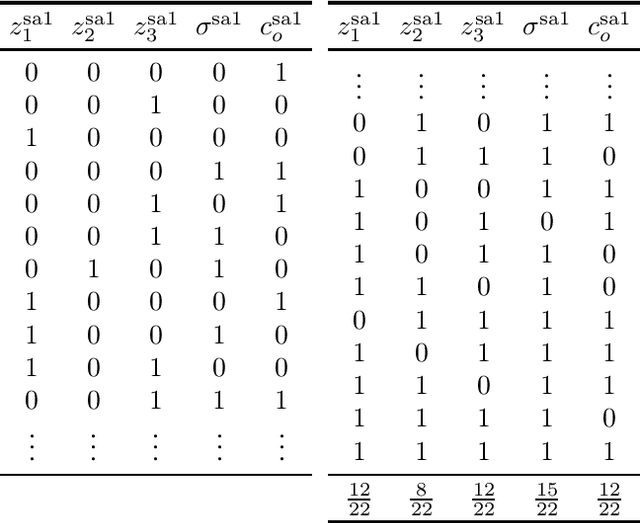
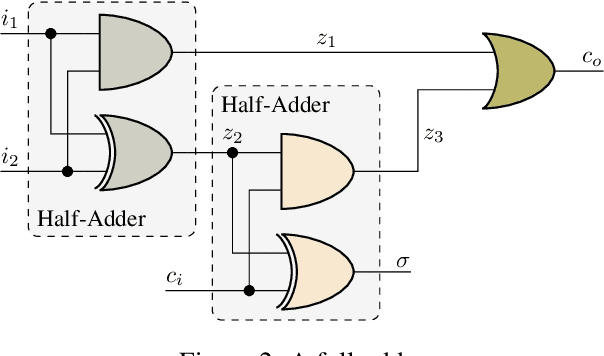
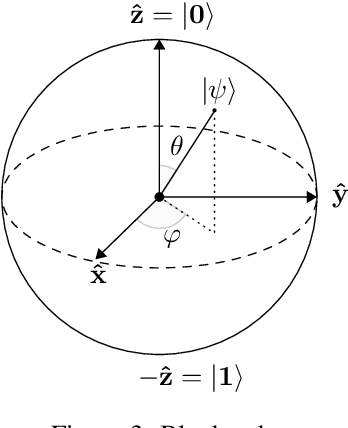
Abstract:Faults are stochastic by nature while most man-made systems, and especially computers, work deterministically. This necessitates the linking of probability theory with mathematical logics, automata, and switching circuit theory. This paper provides such a connecting via quantum information theory which is an intuitive approach as quantum physics obeys probability laws. In this paper we provide a novel approach for computing diagnosis of switching circuits with gate-based quantum computers. The approach is based on the idea of putting the qubits representing faults in superposition and compute all, often exponentially many, diagnoses simultaneously. We empirically compare the quantum algorithm for diagnostics to an approach based on SAT and model-counting. For a benchmark of combinational circuits we establish an error of less than one percent in estimating the true probability of faults.
System Resilience through Health Monitoring and Reconfiguration
Aug 30, 2022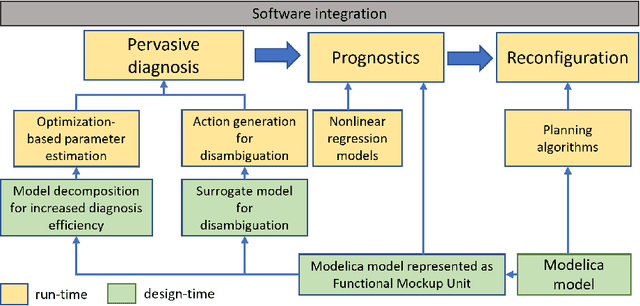



Abstract:We demonstrate an end-to-end framework to improve the resilience of man-made systems to unforeseen events. The framework is based on a physics-based digital twin model and three modules tasked with real-time fault diagnosis, prognostics and reconfiguration. The fault diagnosis module uses model-based diagnosis algorithms to detect and isolate faults and generates interventions in the system to disambiguate uncertain diagnosis solutions. We scale up the fault diagnosis algorithm to the required real-time performance through the use of parallelization and surrogate models of the physics-based digital twin. The prognostics module tracks the fault progressions and trains the online degradation models to compute remaining useful life of system components. In addition, we use the degradation models to assess the impact of the fault progression on the operational requirements. The reconfiguration module uses PDDL-based planning endowed with semantic attachments to adjust the system controls so that the fault impact on the system operation is minimized. We define a resilience metric and use the example of a fuel system model to demonstrate how the metric improves with our framework.
Improving the Efficiency of Gradient Descent Algorithms Applied to Optimization Problems with Dynamical Constraints
Aug 26, 2022
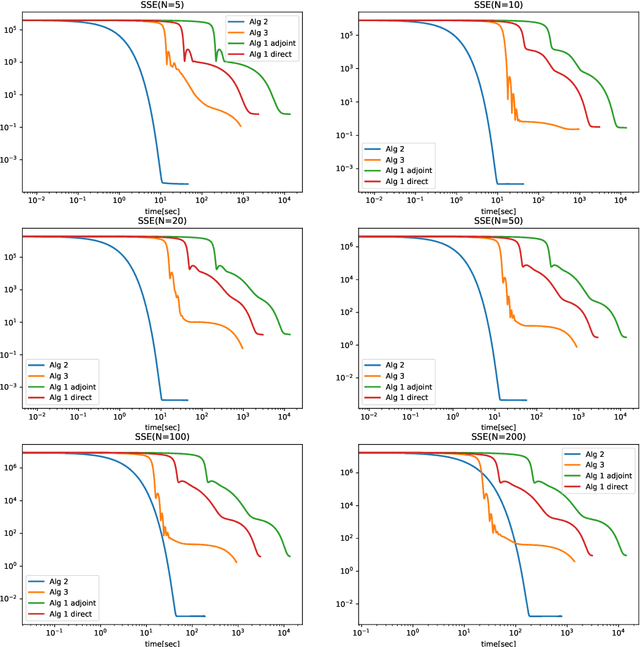

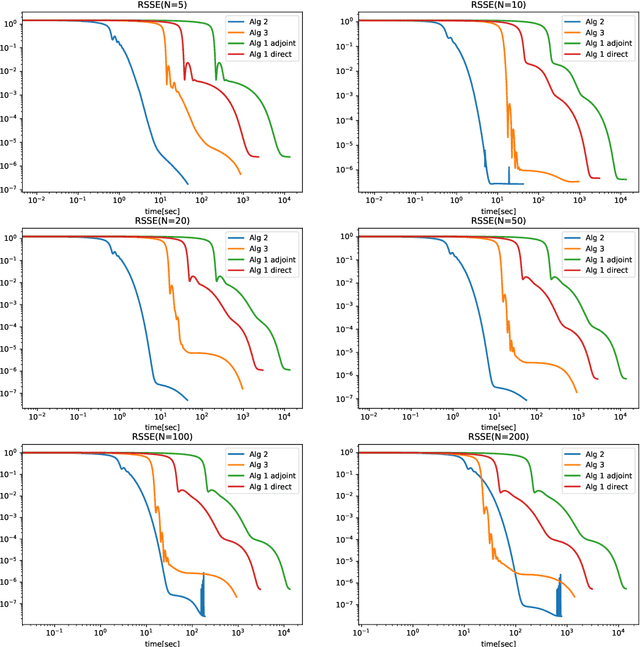
Abstract:We introduce two block coordinate descent algorithms for solving optimization problems with ordinary differential equations (ODEs) as dynamical constraints. The algorithms do not need to implement direct or adjoint sensitivity analysis methods to evaluate loss function gradients. They results from reformulation of the original problem as an equivalent optimization problem with equality constraints. The algorithms naturally follow from steps aimed at recovering the gradient-decent algorithm based on ODE solvers that explicitly account for sensitivity of the ODE solution. In our first proposed algorithm we avoid explicitly solving the ODE by integrating the ODE solver as a sequence of implicit constraints. In our second algorithm, we use an ODE solver to reset the ODE solution, but no direct are adjoint sensitivity analysis methods are used. Both algorithm accepts mini-batch implementations and show significant efficiency benefits from GPU-based parallelization. We demonstrate the performance of the algorithms when applied to learning the parameters of the Cucker-Smale model. The algorithms are compared with gradient descent algorithms based on ODE solvers endowed with sensitivity analysis capabilities, for various number of state size, using Pytorch and Jax implementations. The experimental results demonstrate that the proposed algorithms are at least 4x faster than the Pytorch implementations, and at least 16x faster than Jax implementations. For large versions of the Cucker-Smale model, the Jax implementation is thousands of times faster than the sensitivity analysis-based implementation. In addition, our algorithms generate more accurate results both on training and test data. Such gains in computational efficiency is paramount for algorithms that implement real time parameter estimations, such as diagnosis algorithms.
AI Research Associate for Early-Stage Scientific Discovery
Feb 02, 2022



Abstract:Artificial intelligence (AI) has been increasingly applied in scientific activities for decades; however, it is still far from an insightful and trustworthy collaborator in the scientific process. Most existing AI methods are either too simplistic to be useful in real problems faced by scientists or too domain-specialized (even dogmatized), stifling transformative discoveries or paradigm shifts. We present an AI research associate for early-stage scientific discovery based on (a) a novel minimally-biased ontology for physics-based modeling that is context-aware, interpretable, and generalizable across classical and relativistic physics; (b) automatic search for viable and parsimonious hypotheses, represented at a high-level (via domain-agnostic constructs) with built-in invariants, e.g., postulated forms of conservation principles implied by a presupposed spacetime topology; and (c) automatic compilation of the enumerated hypotheses to domain-specific, interpretable, and trainable/testable tensor-based computation graphs to learn phenomenological relations, e.g., constitutive or material laws, from sparse (and possibly noisy) data sets.
* Paper #203
Playing Angry Birds with a Domain-Independent PDDL+ Planner
Jul 09, 2021
Abstract:This demo paper presents the first system for playing the popular Angry Birds game using a domain-independent planner. Our system models Angry Birds levels using PDDL+, a planning language for mixed discrete/continuous domains. It uses a domain-independent PDDL+ planner to generate plans and executes them. In this demo paper, we present the system's PDDL+ model for this domain, identify key design decisions that reduce the problem complexity, and compare the performance of our system to model-specific methods for this domain. The results show that our system's performance is on par with other domain-specific systems for Angry Birds, suggesting the applicability of domain-independent planning to this benchmark AI challenge.
Interpretable machine learning models: a physics-based view
Mar 22, 2020
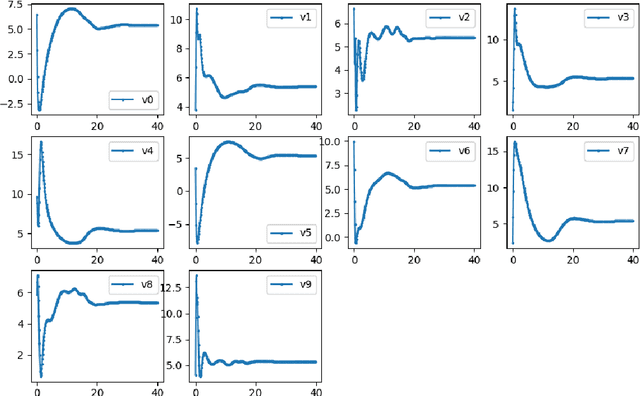


Abstract:To understand changes in physical systems and facilitate decisions, explaining how model predictions are made is crucial. We use model-based interpretability, where models of physical systems are constructed by composing basic constructs that explain locally how energy is exchanged and transformed. We use the port Hamiltonian (p-H) formalism to describe the basic constructs that contain physically interpretable processes commonly found in the behavior of physical systems. We describe how we can build models out of the p-H constructs and how we can train them. In addition we show how we can impose physical properties such as dissipativity that ensure numerical stability of the training process. We give examples on how to build and train models for describing the behavior of two physical systems: the inverted pendulum and swarm dynamics.
Hybrid modeling: Applications in real-time diagnosis
Mar 04, 2020
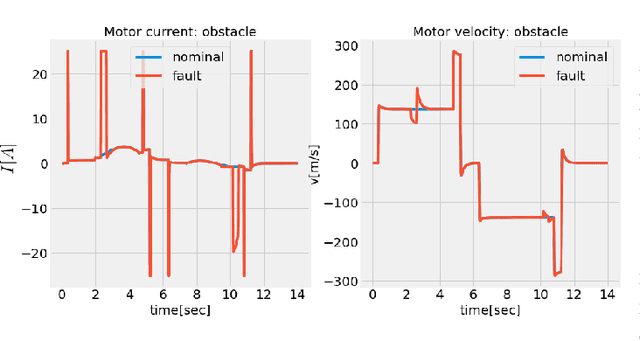
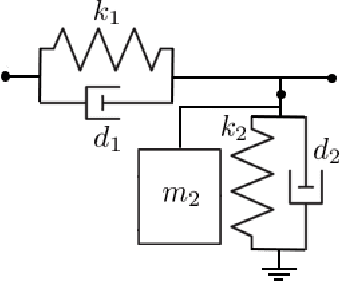
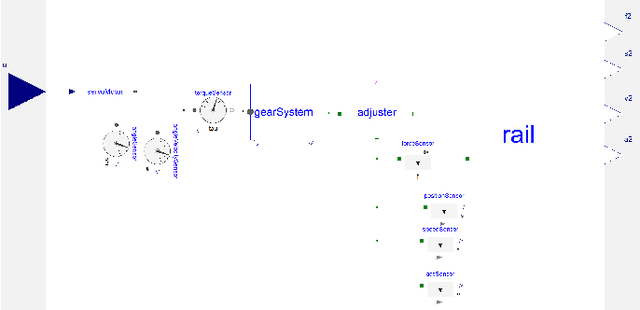
Abstract:Reduced-order models that accurately abstract high fidelity models and enable faster simulation is vital for real-time, model-based diagnosis applications. In this paper, we outline a novel hybrid modeling approach that combines machine learning inspired models and physics-based models to generate reduced-order models from high fidelity models. We are using such models for real-time diagnosis applications. Specifically, we have developed machine learning inspired representations to generate reduced order component models that preserve, in part, the physical interpretation of the original high fidelity component models. To ensure the accuracy, scalability and numerical stability of the learning algorithms when training the reduced-order models we use optimization platforms featuring automatic differentiation. Training data is generated by simulating the high-fidelity model. We showcase our approach in the context of fault diagnosis of a rail switch system. Three new model abstractions whose complexities are two orders of magnitude smaller than the complexity of the high fidelity model, both in the number of equations and simulation time are shown. The numerical experiments and results demonstrate the efficacy of the proposed hybrid modeling approach.
Automatic Support Removal for Additive Manufacturing Post Processing
May 28, 2019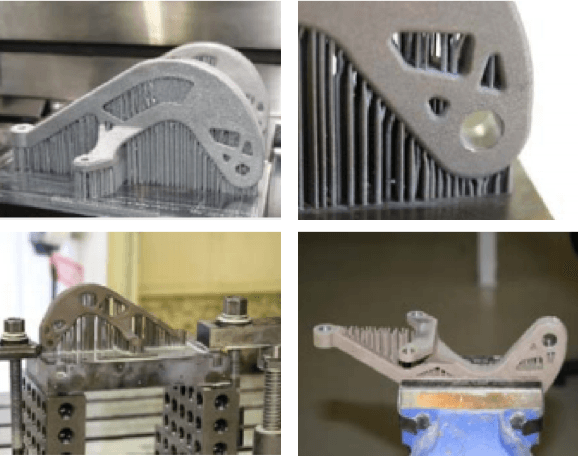

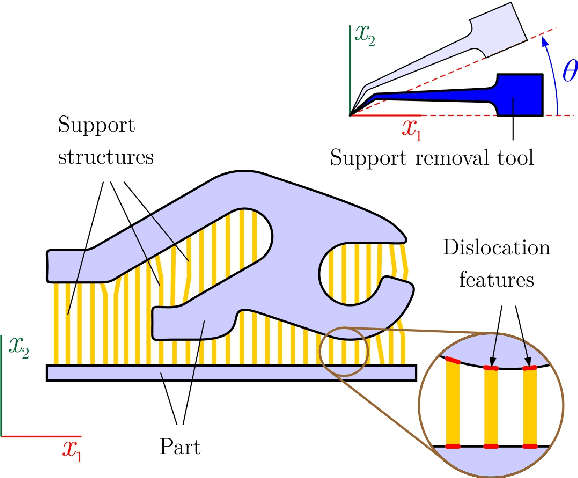
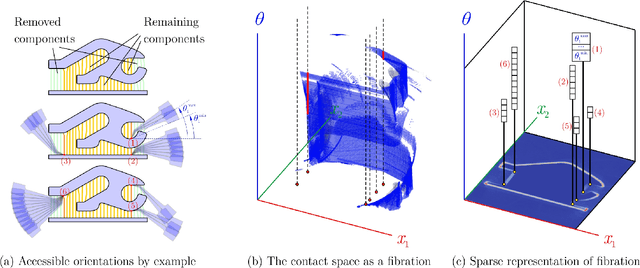
Abstract:An additive manufacturing (AM) process often produces a {\it near-net} shape that closely conforms to the intended design to be manufactured. It sometimes contains additional support structure (also called scaffolding), which has to be removed in post-processing. We describe an approach to automatically generate process plans for support removal using a multi-axis machining instrument. The goal is to fracture the contact regions between each support component and the part, and to do it in the most cost-effective order while avoiding collisions with evolving near-net shape, including the remaining support components. A recursive algorithm identifies a maximal collection of support components whose connection regions to the part are accessible as well as the orientations at which they can be removed at a given round. For every such region, the accessible orientations appear as a 'fiber' in the collision-free space of the evolving near-net shape and the tool assembly. To order the removal of accessible supports, the algorithm constructs a search graph whose edges are weighted by the Riemannian distance between the fibers. The least expensive process plan is obtained by solving a traveling salesman problem (TSP) over the search graph. The sequence of configurations obtained by solving TSP is used as the input to a motion planner that finds collision free paths to visit all accessible features. The resulting part without the support structure can then be finished using traditional machining to produce the intended design. The effectiveness of the method is demonstrated through benchmark examples in 3D.
* Special Issue on symposium on Solid and Physical Modeling (SPM'2019)
Design Space Exploration as Quantified Satisfaction
May 07, 2019
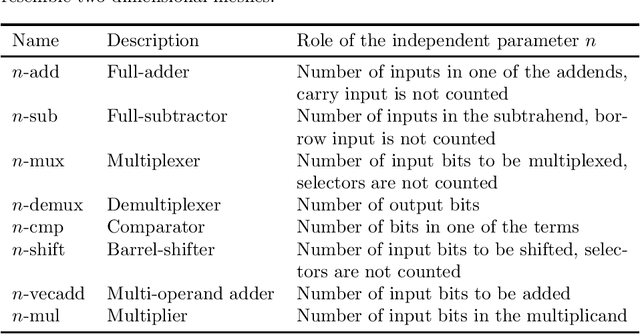
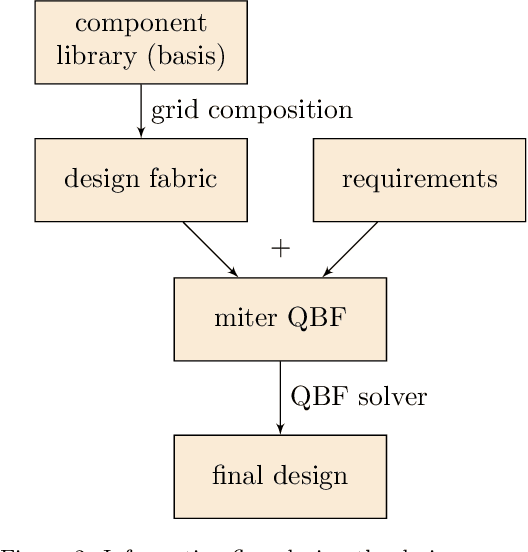

Abstract:We propose novel algorithms for design and design space exploration. The designs computed by these algorithms are compositions of function types specified in component libraries. Our algorithms reduce the design problem to quantified satisfiability and use advanced solvers to find solutions that represent useful systems. The algorithms we present in this paper are sound and complete and are guaranteed to discover correct designs of optimal size, if they exist. We apply our method to the design of Boolean systems and discover new and more optimal classical and quantum circuits for common arithmetic functions such as addition and multiplication. The performance of our algorithms is evaluated through extensive experimentation. We have first created a benchmark consisting of specifications of scalable synthetic digital circuits and real-world mirochips. We have then generated multiple circuits functionally equivalent to the ones in the benchmark. The quantified satisfiability method shows more than four orders of magnitude speed-up, compared to a generate and test method that enumerates all non-isomorphic circuit topologies. Our approach generalizes circuit optimization. It uses arbitrary component libraries and has applications to areas such as digital circuit design, diagnostics, abductive reasoning, test vector generation, and combinatorial optimization.
 Add to Chrome
Add to Chrome Add to Firefox
Add to Firefox Add to Edge
Add to Edge